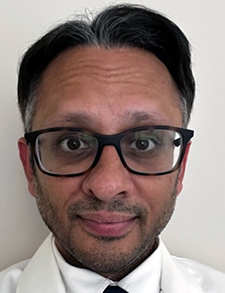 When hospitalist Neil Desai, MD, started as a night doctor, he would get the same question for years. It came from colleagues and family members alike—and no one meant anything by it.
When hospitalist Neil Desai, MD, started as a night doctor, he would get the same question for years. It came from colleagues and family members alike—and no one meant anything by it.
They just didn’t understand.

Dr. Desai
“When are you going to be promoted to a day position?” they’d ask.
Dr. Desai’s response was always the same: “No, no, no, this is what I love doing. I love night medicine. I’m a night owl. This is what I plan on doing for the rest of my career.”
The perception that working the overnight shift as a hospitalist is just a start—a stepping-stone to better hours or a better position—could be seen as a microcosm of how misunderstood the subspecialty is. And it’s just one of the reasons that the Night Medicine Special Interest Group (SIG) led by Dr. Desai is important.
“It’s not just the perception in the hospital, but outside the hospital as well,” he said.
Dr. Desai, who helped start the SIG in 2019 and is now its chair, says the group serves as a voice for night doctors who are often underrepresented. The group has 364 members, according to SHM.
“We didn’t have a place where we could turn to our colleagues and ask, ‘Hey, what’s going on at your university or your hospital?’” Dr. Desai said. “To be able to communicate with one another, to be able to network with one another, to ask questions that were very difficult to get information from. We didn’t have that place.”
The SIG helps link people with questions that other subspecialties have for years been sharing, in part because those cohorts are larger and have received more attention in the past.
“For example, a lot of night people were asking, ‘What are your responsibilities? What is your compensation? How do you get promoted?’” said Dr. Desai, director of the hospitalist night program and the oncology night program at Mount Sinai School of Medicine in New York. “This put us in touch with one another, and we were able to help grow our programs and our professional lives by talking to one another. This was a very big thing for the night doctors across the nation.”
One area of particular importance for hospitalists specializing in overnight medicine is building lines of communication with physicians on other shifts.
“It’s definitely very important to have that communication with our day counterparts,” Dr. Desai said. “That’s one thing we’ve all talked about. Sometimes, nights can be overlooked, and that’s a common theme we’ve heard from different night docs in the network.”
The SIG uses virtual events to help promote discussions on how best to approach day counterparts and perhaps more importantly the C-suite administrators, who all tend to work during times night docs don’t.
“People can feel isolated from the day team, and a lot of the heavy-hitter administrators are there during days, and it’s hard to advance outside of doing your clinical work,” Dr. Desai said. “What’s so great about having this network, is that we’ve given people—and people have given me—ideas on how to do that.
“To talk to your day administrators, to get involved. It’s very important to let them know we’re doing A, B, and C. It’s not that we’re just keeping the patients alive. We’re pretty much covering the entire hospital at night. We’re doing admissions. We’re overseeing nurse practitioners, physician assistants, and residents. Handling renal replacement therapies, codes, X, Y, and Z.”
The communication is working, Dr. Desai says.
“As time has progressed, most hospitals have realized the importance of maintaining a good night staff,” he said. “A lot of hospitals consider night starting at 5 p.m. We’re covering from 5 p.m. until 8 a.m. We’re taking care of patients the majority of the day … as long as we were communicating what we’re doing, the vocalization of that, we’re getting more and more support with that.”
One of the more tangible results of the SIG is a published survey on facts and figures for night doctors, as well as a budding webinar series. The first session was on wellness, a hot topic in a post-COVID-19 world.
There is also an educational program called “Chalk Talk” that aims to connect hospitalists with a useful curriculum specific to night issues. The goal there—via a subgroup of chapter members—is to create a distributable series of talks that night doctors can use for their residents and others.
Every initiative the SIG works on, Dr. Desai says, is aimed at helping grow the group to reach more night hospitalists who could benefit from the shared thoughts.
“We’re on a different time schedule than everybody else is,” he said. “So, being able to have this (group) is invaluable. … this has created that kind of close-knit community.”
Richard Quinn is a freelance writer in New Jersey.
How do you join this group if you are a nocturnist? Thank you